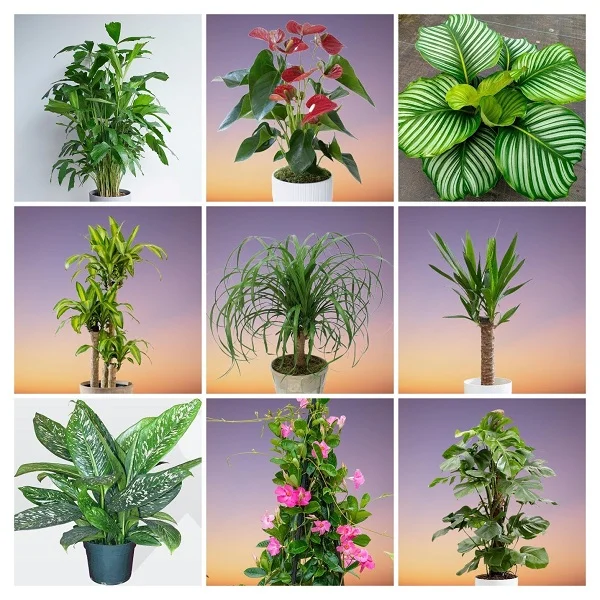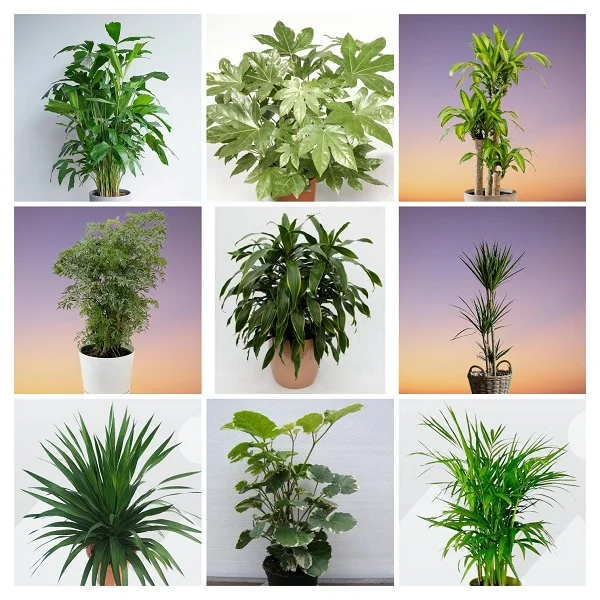Tree Ivy (xFatshedera lizei) Indoor Care, Propagation and Common Problems
Some links in this post may be affiliate links
Tree Ivy (xFatshedera lizei) thrives in medium to bright indirect light, average warmth, moderate humidity and moderately moist, rich, well-drained soil coupled with monthly feeding in the growing season.
xFatshedera lizei also called Ivy Tree, Bush Ivy or Aralia Ivy is an evergreen plant which features large, glossy green leaves, that can be grown as a climbing vine, trailing plant, or bushy shrub.
The symbol x in front of the botanical name indicates that this is an inter-generic hybrid; a cross between plants from different genera.
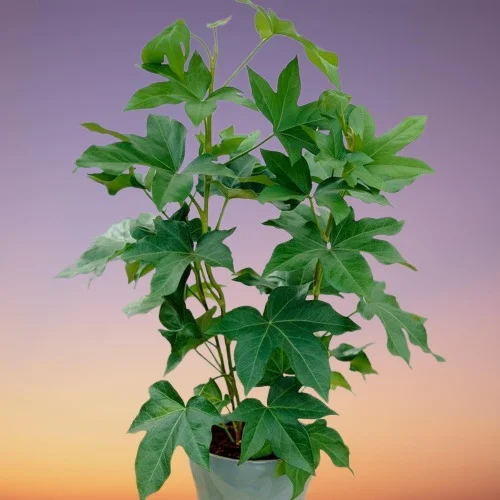
Botanical name: xFatshedera lizei
Common names: Tree Ivy, Ivy Tree, Bush Ivy, Aralia Ivy
Origin
Ivy Tree was created at the Lize Freres tree nursery at Nantes in France in 1912 by crossing Fatsia japonica (Japanese Aralia, the seed plant) and Hedera helix (English Ivy, the pollen plant).
The generic name is derived from the names of the two parent's genera. Tree Ivy combines the shrubby shape of Fatsia with the five-lobed leaves of Hedera.
Size
Bush Ivy can grow to a height of 6 ft or more but will require support or can be grown as a bush by pinching the growing tips. The leaves in Tree Ivy are 7-25 cm long and are borne on a 5-20 cm petiole. The flowers are yellowish-white and the seeds are sterile. Ivy Tree is among the large leafed plants for a bold statement in any space.
Varieties
Several cultivars of Aralia Ivy are available, with dark green to variously white- or yellow-variegated leaves. The variegated types are more difficult to grow than the all green types.
Toxicity
Tree Ivy (xFatshedera lizei) is poisonous to both humans and pets. If ingested, it can cause vomiting, diarrhea and abdominal pains. Keep it away from the reach of children and pets.
Benefits of Tree Ivy Indoors
- Low-maintenance: It thrives with minimal care
- Air-purifying: Removes toxins from indoor air
- Versatile growth: It can be trained as a climber, trailer, or compact shrub
- Non-invasive alternative: Unlike traditional ivy, it won’t spread aggressively
- Great for low-light conditions: It is perfect for homes and offices
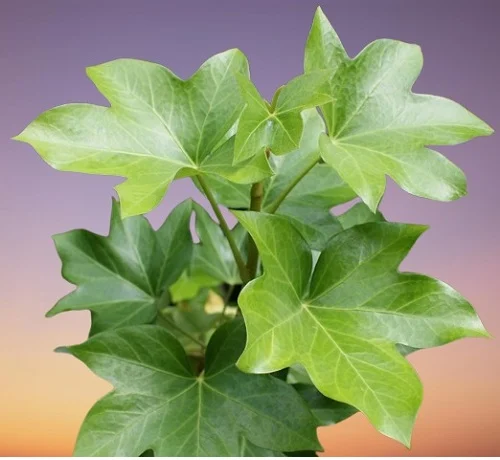
xFatshedera lizei Indoor Care Guide
Tree Ivy is an easy-care houseplant that adds a lush, elegant touch to any space. This guide will cover everything you need to know about Tree Ivy indoor care, including light, water, humidity, pruning, and common problems.
Tree Ivy (xFatshedera lizei) blossoms in medium to bright indirect light, average warmth 16-260C, moderate humidity of 50-55% and moderately moist, fertile, well-drained, all purpose potting soil coupled with monthly feeding during the growing season.
Regular pruning is needed to keep the plant neat and tidy as well as encourage a bushy growth. Keep reading for more on these growing conditions and how to achieve them.
Light Requirements
Tree Ivy grows best in bright light or light shade. The all green types require less light than the variegated types. Keep it away from direct sunlight as it may cause scorching.
If the leaves start to lose their variegation or look pale, move the plant to brighter light or instal a grow light to supplement the natural light.
Rotate the pot regularly to ensure that the plant is receiving light on all sides for uniform growth and prevent leggy growth.
Watering
Water Tree Ivy thoroughly during the growing season while allowing the top 2 inches of soil to dry a little between waterings.
Lessen watering during the cold period as growth is minimal at this time but do not allow the soil to dry out completely to prevent wilting and drooping.
Ensure that the pot has a draiange hole to prevent the soil from getting soggy as it can lead to yellowing and root-rot and eventual death of the plant.
Use room temperature water to avoid plant shock which can result in reduced growth and leaf drop. In addition ensure that the water is free of chlorine and other dissolved chemicals to avoid brown leaf tips. Learn how to water houseplants correctly.
Temperature and Humidity
Tree Ivy prefers average temperature of 16-260C. Keep it away from cold and hot drafts from windy doors, drafty windows, heaters, air conditioners, to avoid sudden changes in temperature which can cause leaf drop.
Tree Ivy has no need for high humidity, moderate humidity of 50-55% is adequate for this plant. However, for lush growth and to reduce pest infestation, set the pot on a wet pebble tray to raise humidity. Do not mist the plant as misting promotes fungal diseases.
Regularly clean the leaves by damp wiping with a soft cloth to keep them clean and also discourage pest infestations. Learn more on how to clean houseplants.
Potting Medium
The best potting mix for Tree Ivy well-draining, organic-rich potting mix to prevent it from getting soggy while providing the required nutrients. Most all purpose potting mixes are good for this plant.
Fertilizer
Feed Tree Ivy with a balanced, water-soluble fertilizer every 3-4 weeks during the growing period for a lush growth. Minimize or withhold feeding in the cold season to avoid fertilizer burn as growth is minimal at this time.
Brown leaf tips and a white crust on soil are signs of overfertilizing. Flush the soil with water every 2-3 months to remove excess salts from the soil.
Repotting
Repot Tree Ivy every 2-3 years during the growing period when roots outgrow the pot or the soil becomes compacted. Use a pot which is 1 size larger and loose free-draining soil. Make sure that the pot has a drainage hole to prevent the soil from getting soggy as it can lead to root-rot. Take a look at these ceramic pots with drainage holes and saucer on Amazon.
Pruning & Maintenance
Pruning Tree Ivy involves removal of yellow and dead leaves to maintain the plant neat as well as reduce pest and disease infestations.
To encourage a bushy and compact growth, pinch off the growing tips. The tips can be used to propagate new plants. You may also train the plant on a trellis or moss pole for vertical growth or leave it to trail down from hanging baskets.
Propagation
Tree Ivy (xFatshedera lizei) can be propagated at the beginning of the growing season from stem-tip cuttings.
How to propagate Tree Ivy from stem-tip cuttings in soil
Take stem-tip cuttings of about 4-5 inches length from a healthy Tree Ivy. Strip off the lower leaves from the cutting.
Dip the cut end of the cuttings in a rooting hormone and insert them in moist rooting soil.
Place the set up in a warm, well-lit place and maintain the soil moist until new growth emerges and substantial growth has been observed.
Transfer the rooted Bush Ivy cuttings to individual pots and begin routine care. For a fuller plant, transfer several cuttings into one pot.
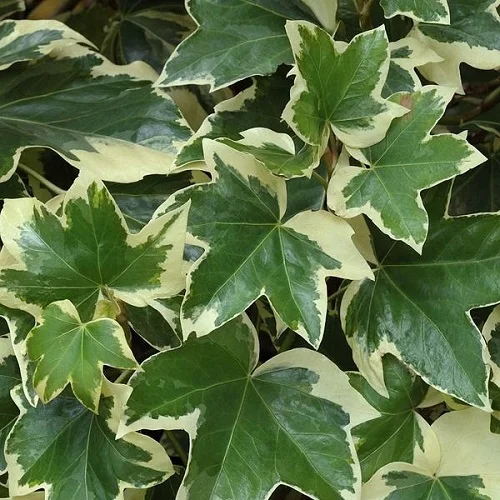
xFatshedera lizei Problems
Tree Ivy (xFatshedera lizei) problems include yellow leaves, brown leaf tips, drooping leaves, leaf drop, leggy growth, loss of variegation, pests and diseases among others. Keep reading for more on these problems and how to fix them.
Yellow leaves
The main causes of yellow leaves in Tree Ivy are overwatering, poor drainage, and low light. Reduce watering, ensure proper drainage, and move the plant to brighter indirect light.
Brown leaf tips
Brown leaf tips in Tree Ivy are due to low humidity, fluoride in tap water, or over-fertilization. Increase humidity, use filtered water, and flush the soil occasionally.
Drooping leaves
Underwatering, temperature stress, or poor air circulation are the major causes of drooping leaves in Tree Ivy. Water when soil is slightly dry, keep it away from drafts, and improve airflow for your plant.
Pests
The common pests in Tree Ivy are aphids, mealybugs and scale insects. Isolate the affected plant to prevent spread to other plants. Learn how to identify and get rid of pests in houseplants.
Diseases
The common diseases in Tree Ivy are leaf spot and root-rot which are prevalent in too wet conditions. Avoid soggy soil by ensuring that the pot has a drainage hole and that the soil is free-draining.
Loss of variegation
Too little light is one reason for loss of variegation in variegated Tree Ivy. Move the plant to a brighter spot where it will receive medium to bright indirect light or instal a grow light if the natural lighting is not sufficient. Check out this guide on understanding light for houseplants.
The second reason for loss of variegation in variegated Tree Ivy is inadequate growth space if the plant is pot-bound. Repot the plant every year in a pot 1 size larger than the current one to provide adequate growth space for the plant.
Brown leaves and leaf drop
One possible cause of brown leaves accompanied by leaf drop in Tree Ivy is soggy soil. Maintain the soil moist but not soggy by ensuring that there is proper drainage of both the soil and the pot.
The second possible cause of brown leaves accompanied by leaf drop in Tree Ivy is high temperatures. Keep it away from hot air vents or any source of hot air and maintain average warmth of 16-260C. Check out this guide on understanding temperature for houseplants.
Leggy growth
If Tree Ivy receives too little light the leaves will be small and the growth is leggy. Move the plant to a brighter spot in medium to bright indirect light or instal a grow light if the natural lighting is not adequate.
Conclusion
Tree Ivy (x Fatshedera lizei) is a hardy, low-maintenance indoor plant that thrives in medium to bright indirect light and adds a tropical touch to any home. By providing moderate watering, occasional pruning, and proper humidity, you can enjoy a lush, healthy plant year-round.
Frequently Asked Questions
1. How often should I water my Tree Ivy?
Do not water on a schedule. Allow the top 2 inches of soil to dry out between waterings.
2. Can Tree Ivy tolerate low light?
Yes, Tree Ivy adapts well to low-light conditions, but it thrives best in medium to bright, indirect light.
3. Why is my Tree Ivy losing leaves?
Leaf drop in Tree Ivy is often caused by cold drafts, low humidity, or overwatering. Keep the plant in a stable, warm environment with moderate humidity.
4. Is Tree Ivy toxic to pets?
Yes, Tree Ivy is toxic to pets. If ingested, it can cause vomiting, diarrhea and abdominal pains. Keep it out of reach of cats and dogs.
5. Can I propagate Tree Ivy from cuttings?
Yes, Tree Ivy propagates easily from stem cuttings. Simply cut a 4-6 inch stem, place it in water or soil, and keep it in a warm, humid environment until roots develop.
6. What is the best pot for Tree Ivy?
A terracotta or plastic pot with drainage holes is ideal for Tree Ivy to prevent overwatering and waterlogging issues.
You liked it? Share on social media.
Related Content
Amazon Associates Disclosure
Homeplantsguide.com is a participant in the Amazon Services LLC Associates Program, an affiliate advertising program designed to provide a means for sites to earn advertising fees by advertising and linking to amazon.com.




